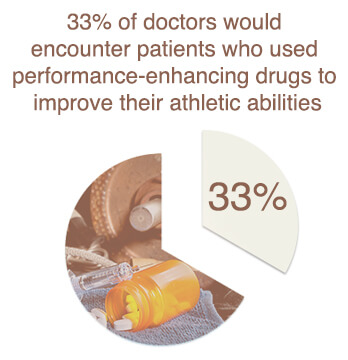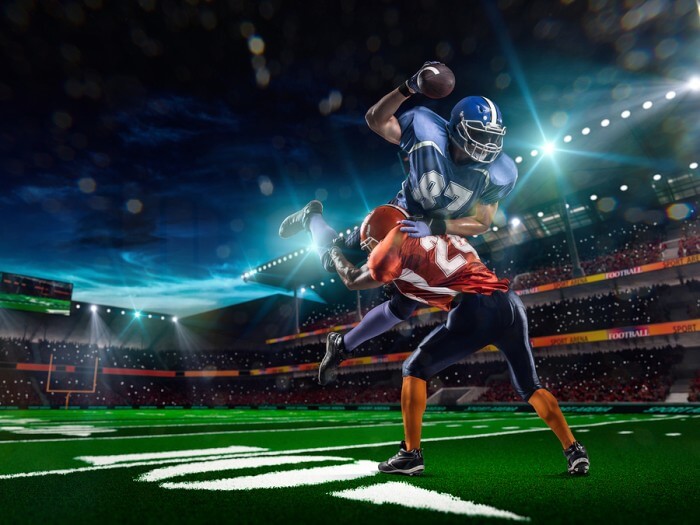It’s easy to imagine all the plaudits and praise that professional sportspeople get, but there’s no denying the relentless toll that it takes to perform week after week in front of millions of people, with your every move being scrutinized and scorned and history and a life-changing paycheck on the line. It’s little surprise, then, that athletes sometimes resort to substance abuse to cope with what being a football player, baseball player, wrestler, boxer, hockey player, or basketball player takes out of them.
Addiction in professional sports is a complicated, tragic relationship with devastating results that often go unseen until it’s too late.
The Addictions of Athletes
One of the risks facing sportsmen and sportswomen is that there are many forms and reasons for the development of a drug or alcohol addiction. Broadly speaking, these can be broken out into three categories:
- An addiction to performance-enhancing substances
- An addiction to stimulants to alleviate depression
- An addiction to prescription painkillers
Because of these factors (among a number of others), the Partnership for Drug-Free Kids states that sportspeople are “more prone than the general population to substance abuse.”[1]
A Brief Overview of Performance-Enhancing Substances

The use of banned substances in order to unnaturally make athletes perform at heightened levels is nothing new – the British Journal of Sports Medicine claims that “doping” is as old as the concept of sport itself.[2] Furthermore, the Daily Mail quoted the British Medical Association as saying the use of performance-enhancing substances (such as anabolic steroids) was “widespread” in the United Kingdom.[3] In 2002, the British Medical Journal described the culture of using such drugs as “deeply entrenched” among athletes, despite the well-publicized health risks of the practice. The journal found that 33 percent of doctors would encounter patients who used performance-enhancing drugs to unnaturally and illegally improve their athletic abilities.[4]
A similar finding in Australia brought to light the “widespread use” of illegal substances to boost performance among athletes, with scientists and coaches obtaining drugs from organized crime rings. The Australian government report was made public a month after Lance Armstrong confessed to multiple doping offenses in his Tour de France appearances.[5]
The Other Big Problem
But the problem of performance-enhancing substance abuse in the sporting world is only one of a number of drug-related concerns. Chief on the list – the National Football League’s “other big problem”, according to ESPN (the first one is concussions and other forms of head injuries) are painkillers. An ESPN columnist writes that the league does not fully disclose the addictive nature of pain medication, leading players to consume large doses of the drugs even when they don’t need to.[6]

The results have been catastrophic. Ryan Leaf played for the San Diego Chargers in 1998 and the Dallas Cowboys in 2001, but exacerbated a wrist injury and became addicted to pain medication. Leaf unexpectedly retired from the game in 2002 and cycled through a number of jobs. However, he was dogged by his injuries, violent temper, the indignity of being considered “the biggest draft bust in the history of professional sports,” and his addiction to pain medication.[7] Leaf pleaded guilty to burglary or illegal possession of narcotic painkillers. In 2014, he was sentenced to five years in jail for breaking and entering a private residence to steal prescription pain drugs, but he was released in December of that year and is currently on probation.[8]
The ESPN columnist writes of other professional football players, like Craig Newsome who became addicted to Percocet after multiple surgeries. In 2000, Newsome was charged with attempting to obtain a prescription painkiller medication under false pretenses.[9] Earl Campbell’s naturally occurring spinal stenosis was made significantly worse by the numerous hits he sustained as one of the greatest college football players in history.[10] Requiring the use of a cane as early as 40 years of age, Campbell started taking his Vicodin and OxyContin with Budweiser, believing that – even as his life disintegrated around him – he couldn’t be doing that much harm, because his story was not that of other drug addicts who were using more nefarious drugs like cocaine and heroin. Now sober, Campbell is an advocate for increasing research into other, less risky and less addictive forms of pain pharmacotherapy.[11]
The Painkiller Addiction
Other players have their own tales of woe. Walt Sweeney blamed the NFL for his football injuries directly leading to his painkiller addiction, and further claimed the San Diego Chargers freely distributed narcotics to players. Ray Lucas, who played for the New York Jets and the Miami Dolphins, told The New York Times that numerous neck and back injuries (and resultant surgeries) led him to taking as many as 25 prescription painkillers a day, or 800 pills a month. Having absolved the NFL of responsibility, Lucas now works with a pharmaceutical company to educate the public on the dangers of prescription medication abuse and inform them of their options when it comes to receiving drugs for pain management.[12]
A 23-year-old former athlete described how he developed a deep addiction to opiates after he was prescribed Vicodin for a torn ACL. Another player liked his oxycodone prescription so much that he started abusing it, eventually moving on to heroin. Athletes, with their chronic and debilitating physical pain, as well as incredible amounts of pressure to perform, are probably more at risk to fall foul of the “gateway” nature of prescription opiates than the general population.[13]

On that note, Harvard Medical School published a newsletter that warned that the high rate of drug addictions was fueled by painkillers, primarily because prescription narcotics target the same area of the brain that illegal drugs (like heroin) do. While the effect can be milder and less nefarious, a player nursing a sports-related injury, with the expectation that he (or she) should play through the pain – notwithstanding the possibility of exacerbating the injury by rushing back into action – risks being on opioid therapy for a dangerously long period of time.[14]
Brain Injuries and Addiction
While these stories have their elements of tragedy, the players involved lived to tell the story (sometimes to inspiring degrees). The same can’t be said for Tom McHale, an offensive guard for the Tampa Bay Buccaneers, who died at the age of 45 from an accidental drug overdose. An autopsy revealed that McHale had chronic traumatic encephalopathy at the time of his death, a degenerative brain disease that is caused by repeated head trauma.[15]

Studies conducted in the mid-1990s found that between 10 and 20 percent of people with a brain injury to the degree of severity of chronic traumatic encephalopathy develop a substance abuse problem.[16] Similarly, the Journal of Neurotrauma published an article that showed traumatic brain injuries “[disrupt] incentive motivation neurocircuitry,” increasing the risk of substance abuse in patients.[17] In the same way that the brain’s systems responsible for natural rewards are taken over by harmful levels of alcohol and drug consumption, according to researchers, traumatic brain injuries have a similar effect.
The study also discovered that repeated injuries to a specific part of the brain can cause a personality disorder that is might be a risk factor for substance abuse. The finding in the Journal of Neurotrauma is similar to that of a study that was published in Medicine & Science in Sports & Exercise. There, researchers reported that sustained instances of concussion as a result of sports injuries were positively related to a greater risk of major depression in retired football players.[18] The Medicine & Science in Sports & Exercise study surveyed 2,552 retired football players, finding that the frequency of depression diagnoses increased with the instances of concussions. While depression is a serious problem in and of itself, the stigmatizing of the condition within sporting cultures[19] adds to the issue, with many players ignoring the symptoms or refusing to seek help for their mental health for fear of being seen as “mentally weak” by their teammates, their coaches and their fans.[20] The non-profit Institute of Medicine identified this as a “culture of resistance” that resists self-reporting concussions, for fear that to do so would let the team down.[21]
These factors all come together to put athletes at a very high risk for developing a substance abuse problem.[22]
While there is always the risk of an addiction to prescription painkillers forming when a patient is in chronic pain and stress,[23] the situation is greatly compounded by the likelihood of athletes in combat sports regularly experiencing injuries that put them at an even more increased risk for developing a serious substance abuse problem. In reporting on the story of an Ohio State athlete who committed suicide (who had a reported history of concussions), the Huffington Post quoted the chairman of psychiatry at Indiana University as saying that brain injuries “increase people’s risk for depression,” and most work done on the subject has dealt with people who have had “severe head injuries.”[24]
Wrestling, Addiction, and Death

Of course, football is not the only activity that causes physical and mental pain (to say nothing of severe head injuries) to the point of compelling sufferers to find respite – however tempting or temporary – in prescription medication and banned substances. Notwithstanding the staged nature of professional wrestling, the athleticism, injuries, and deaths are very real.Most of the premature deaths in professional wrestling, says the Washington Post, could be attributed to drugs.[25] While rampant steroid use has been rumored, denied, and exposed to various degrees, many wrestlers – who spend three to four days every week traveling, performing, and attending media events – turn to narcotics and painkillers to work through the grueling pain of wrestling and the depression of endless touring cycles.[26]
Professional wrestling culture “breeds addicts,” according to a Post article, which was published after Eddie Guerrero, a decorated athlete who wrestled across the United States, Mexico, and Japan, died at just 38 years of age. Throughout his career, Guerrero publicly battled alcohol and prescription painkiller abuse, and his death in 2005 flung the door open on the unhealthy, and unseen, lifestyle that wrestlers have to endure in order to keep working. Speaking to the Post after Guerrero’s death, a former wrestler explained that, much like professional football players, wrestlers are expected to simply “suck it up,” knowing that if they don’t self-medicate to battle through the physical and mental wear and tear of the job, there are hundreds of younger wrestlers waiting in the wings to take their place.
Compare this mindset and that of a large swath of sporting cultures (perhaps especially professional football), where “playing through the pain” confers “hero status” on players and is summarily encouraged by coaches, fans, and the media.[27]
‘The Brain of an 85-Year-Old Alzheimer’s Patient’
Guerrero’s death may have been a factor in the double-murder suicide perpetrated by Chris Benoit, another highly decorated wrestler, in 2007. During his career, Benoit was notable for his willingness to be hit in the head with a steel folding chair, which was often used as a prop weapon in wrestling storylines. In June of 2007, Benoit killed his wife and 7-year-old son in their Georgia home, then committed suicide.[28] Journal entries discovered after the incident showed Benoit had plunged into a deep depression following the death of Guerrero, who was a close friend of his. An autopsy on Benoit showed the damage to his brain from multiple concussions was so immense, it looked like the brain of an 85-year-old Alzheimer’s patient (Benoit was 40 when he killed himself).[29]
Benoit’s autopsied brain also showed almost total signs of chronic traumatic encephalopathy, the same form of brain damage that the studies published in the Journal of Neurotrauma and Medicine & Science in Sports and Exercise found were related to an increased risk of major depression in football players. In fact, one of CTE’s most common symptoms is depression,[30] and the frequent blows to the head Benoit sustained as part of his wrestling career might account for damage that would have caused depression and uncharacteristic behavior.[31] Toxicology tests conducted post-mortem found that Benoit had Xanax, an antidepressant, and hydrocodone, a painkiller, in his blood.[32]
WWE’s Response
WWE (the professional wrestling organization for which Benoit was working when he killed himself) implemented a drug, alcohol, and cardiac screening program in 2006, as a response to the death of Eddie Guerrero (who was also a WWE performer at the time of his death). The WWE Talent Wellness Program tests employees for abuse of prescription and recreational drugs,[33] and the company has penalized wrestlers[34] – even highly accomplished and popular ones – for failing drug tests.[35]
WWE has also banned the use of steel chair shots to the head, specifically citing the danger of concussions and other impact-based damage. Wrestlers, referees, and other personnel are required to attend a yearly seminar on the topic of how to avoid, prevent, and notice concussions.[36] In 2011, two of the company’s top performers – including one who was actually a behind-the-scenes executive vice president at the time[37] – were both fined when they violated this rule during a match.[38]
However, both WWE’s concussion and drug policies have come under attack from former wrestlers and industry observers who claim the company selectively enforces the system. Most recently, Phil Brooks (who wrestled for WWE under the stage name “CM Punk”) claimed that he passed a concussion test the day after receiving a concussion at a pay-per-view event,[39] and that WWE’S concussion policy exists to look presentable to the mainstream media (which has often been critical or dismissive of professional wrestling[40]) and not to protect the safety of its wrestlers.[41] WWE’s Wellness Policy has received criticism for not being transparent, and for the company protecting its star performers from the more serious penalties laid out in the policy.[42] The publisher of the Wrestling Observer newsletter said that prescription drug use in WWE remained “prevalent,” even five years after the implementation of the Wellness Program.[43]
The NFL’s Response
In 2013, WWE updated its Wellness Policy to allow its performers to seek a “Therapeutic Use Exception” for a prohibited drug if they could show legitimate medical use and WWE’s Medical Director signs off on it.[44] This is similar to how, notwithstanding the National Football League’s ban on the prescription medication Adderall because of the high potential for abuse (with the possibility of physical or physiological dependency, according to the U.S. Drug Enforcement Administration[45]), football players can still receive Adderall prescriptions while under contract if they can obtain a therapeutic use exemption from the NFL.[46]
Perhaps it’s no surprise that there’s a good amount of crossover between professional/collegiate football and professional wrestling; both forms of entertainment can be brutally violent, requiring physiques chiseled out of stone and a willingness to sacrifice personal safety to hear the roar of an enraptured crowd.[47] So, similar to the way WWE has implemented measures to protect the physical and biological health of its performers (albeit with questionable success), the NFL has also taken steps to reduce the risk of concussions, and resultant depression and addiction, its own athletes face.

In 2013, for example, the NFL introduced a new rule that would penalize players for striking opponents with the crown of their helmets. Even as former players criticized the rule for various reasons – running backs claimed that their ability to protect themselves would be diminished – league officials insisted that reducing the likelihood of players sustaining dangerous head injuries was of primary concern.[48]Prior to the helmet rule, the Medical Director of the NFL Players’ Association borrowed a concussion identification tactic from the United States military – two players would be paired up with the job of keeping an eye on each other. If one player notices his “battle buddy” showing signs of a concussion after a particularly violent play, it would be his job to alert trainers to the possibility of a concussed teammate on the field. One player who benefitted from this was Green Bay Packers quarterback Aaron Rodgers, who left a 2010 game against the Detroit Lions on the observation of his battle buddy (wide receiver Donald Driver). Rodgers recuperated for a week, returned to the team healthy, and led the Packers to victory in Super Bowl XLV.[49]
The NFL has also updated its drug-testing program. In late 2014, in collaboration with the NFL Players’ Association, the league raised the threshold for positive tests of marijuana and amphetamine usage (amphetamines make up one of the chemical components of Adderall, which is why it is both a heavily controlled substance and why the NFL has made room for its prescription and use among players), while also testing players for the use of human growth hormone (HGH) and other performance-enhancing drugs.[50] Players who commit initial and minor offenses will be automatically enrolled in a substance abuse education program, while repeated offenses will be penalized by fines and suspensions that can last up to two years.[51]
Organizations like the NFL and WWE have, indeed, come a long way in protecting their performers from the inherently dangerous nature of their entertainment and from the layers of damage it can wreak. The argument can be made that it is safer to be a professional football player or a professional wrestler now than it has ever been in the past. But if sport truly calls on its participants to play for glory and for the adulation of a cheering crowd, then it is human nature to push through pain and safety. If that is true, then no matter the overtures made by the NFL and WWE, addiction will always be a seedy underbelly of the professional sport industry.
Citations
[1] “Retiring Olympic Athletes May Be At Risk For Substance Abuse, Studies Suggest.” (August 2012). Partnership for Drug-Free Kids. Accessed January 14, 2015.
[2] “Competing Against Doping.” (2010). British Journal of Sports Medicine. Accessed January 14, 2015.
[3] “Use of Drugs in Sport “Widespread”.” (n.d.) The Daily Mail. Accessed January 14, 2015.
[4] “Athletes Risk Their Lives By Routine Use of Performance Enhancing Drugs, Says BMA.” (April 2002). British Medical Journal. Accessed December 6, 2014.
[5] “Australia Rocked by Allegations of Drug and Crime Links in Sports.” (February 2013). CNN. Accessed January 14, 2015.
[6] “Painkillers, NFL’s Other Big Problem.” (May 2014). ESPN. Accessed January 15, 2015.
[7] “In NFL Draft, Beware of Next Ryan Leaf.” (March 2005). MSNBC Sports. Accessed January 15, 2014.
[8] “Former NFL QB Ryan Leaf Released From Montana Prison.” (December 2014). USA TODAY. Accessed January 15, 2014.
[9] “Ex-Packer Newsome Faces Drug Charges.” (June 2000). Chicago Tribune. Accessed January 15, 2015.
[10] “25 Greatest Players in College Football.” (January 2008). ESPN. Accessed January 15, 2015.
[11] “Earl Campbell: Addiction to Painkillers and His Campaign to Help Others.” (October 2013). The Post Game. Accessed January 15, 2015.
[12] “Q. and A. With Ray Lucas.” (May 2012) The New York Times. Accessed January 15, 2015.
[13] “Sports Injuries Can Lead to Opiate Addiction.” (June 2014). MYFOXNY. Accessed December 7, 2014.
[14] “Painkillers Fuel Growth in Drug Addiction.” (January 2011). Harvard Health Publications. Accessed December 7, 2014.
[15] “Football and Progressive Brain Damage: Tom McHale of NFL Suffered from Chronic Traumatic Encephalopathy When He Died in 2008.” (January 2009). ScienceDaily. Accessed January 15, 2015.
[16] “Substance Abuse and Traumatic Brain Injury.” (n.d.) Brainline.org. Accessed January 15, 2015.
[17] “Does Traumatic Brain Injury Increase Risk for Substance Abuse?” (July 2009). Journal of Neurotrauma. Accessed January 15, 2015.
[18] “Concussion Linked to Depression in Retired American Football Players - New Research Coincides with Expert Presentation at ACSM Annual Meeting.” (June 2007). Medical News Today. Accessed January 15, 2015.
[19] “Update: Ex-Olympian Spirals into Depression, Calls for More Mental Health Education in Sports.” (June 2013). Global News. Accessed January 15, 2014.
[20] “Depression in Athletes: Is It Being Ignored?” (October 2013). Philly.com. Accessed January 15, 2015.
[21] “Don’t Tell Coach: Playing Through Concussions.” (November 2013). The New York Times. Accessed January 17, 2015.
[22] “Depression and Substance Abuse: The Chicken or the Egg?” (2010). PsychCentral. Accessed December 7, 2014.
[23] “Back Pain: Medication and Addiction.” (August 2006). WebMD. Accessed December 7, 2014.
[24] “Ohio State Football, Wrestling Teams Mourn Death of Kosta Karageorge.” (December 2014). The Huffington Post. Accessed January 16, 2015.
[25] “The Ultimate Warrior Joins a Long List of Wrestlers Who Died Prematurely.” (April 2014). The Washington Post. Accessed January 15, 2015.
[26] “Biggest Problem in WWE: The Travel Schedule.” (August 2012). Bleacher Report. Accessed January 15, 2015.
[27] “In NFL, Playing Through Pain Comes With Territory.” (January 2015). The Guardian. Accessed January 15, 2015.
[28] “Wrestler Killed Wife and Son, Then Himself.” (June 2007). The New York Times. Accessed January 15, 2015.
[29] “Benoit’s Brain Showed Severe Damage From Multiple Concussions, Doctor and Dad Say.” (September 2007). ABC News. Accessed January 15, 2015.
[30] “Wrestler Chris Benoit’s Brain’s Forensic Exam Consistent With Numerous Brain Injuries.” (September 2007). Science Daily. Accessed January 15, 2015.
[31] “Lawyer: Benoit Depressed Over Death of Guerrero.” (September 2007). ESPN. Accessed January 15, 2015.
[32] “Chris Benoit: Was Roid Rage to Blame?” (n.d.) WebMD. Accessed January 15, 2015.
[33] “Abuse and Drug Testing Policy.” (July 2013). WWE Corporate. Accessed January 15, 2015.
[34] “WWE Star Suspended 30 Days for Wellness Policy Violation.” (July 2013). Examiner.com. Accessed January 16, 2015.
[35] “Rey Mysterio Suspended by WWE for Violating Talent Wellness Program.” (April 2012). International Business Times. January 16, 2015.
[36] “WWE and ImPACT Concussion Management Program.” (n.d.) WWE Corporate. Accessed January 16, 2015.
[37] “Executive Officers.” (n.d.) WWE Corporate. Accessed January 16, 2015.
[38] “Triple H, the Undertaker Fined for Chair Shot at Wrestlemania XXVII.” (April 2011). The Baltimore Sun. Accessed January 16, 2015.
[39] “CM Punk Slams WWE’s Health and Wellness Policy, Says He Was Fired on His Wedding Day.” (November 2014). The Washington Post. Accessed January 16, 2015.
[40] “Mainstream Media vs. Wrestling Media: The Love-Hate Relationship, Its Origin.” (August 2014). Examiner.com. Accessed January 16, 2015.
[41] “WWE Fired CM Punk on His Wedding Day, the Health Issue That Should Have Killed Him and More: Quick Highlights of Punk Interview on Cabana Podcast.” (November 2014). PWInsider.com. Accessed January 16, 2015.
[42] “CM Punk & the WWE Healthcare Controversy.” (December 2014). 411 Mania. Accessed January 16, 2015.
[43] “Substance Abuse in WWE Dogs Linda McMahon’s Senate Run.” (October 2010). Hartford Courant. Accessed January 17, 2015.
[44] “Changes Made to WWE Wellness Policy, How Can a Talent Remove a Previous Violation?” (November 2013). Wrestle Zone. Accessed January 16, 2015.
[45] “Practitioner’s Manual - Section II.” (n.d.) Office of Diversion Control, Drug Enforcement Administration. Accessed January 16, 2015.
[46] “NFL, Other Leagues Deal With Players’ Use of Amphetamine Adderall.” (September 2013). The Denver Post. Accessed January 16, 2015.
[47] “7 Professional Wrestlers Who Played NFL Football.” (August 2014). CBS Pittsburgh. Accessed January 16, 2015.
[48] “With Eye on Concussions, NFL Adopts New Rule on Helmet Hits.” (March 2013). PBS. Accessed January 16, 2015.
[49] “NFL Has Come a Long Way in Dealing With Concussions.” (November 2012). Milwaukee Journal Sentinel. Accessed January 17, 2015.
[50] “NFLPA Approves New Drug Policy; HGH Testing Included.” (September 2014). NFL.com. Accessed January 17, 2015.
[51] “NFL, Union OK New PED Policy.” (September 2014). ESPN. Accessed January 17, 2015.


